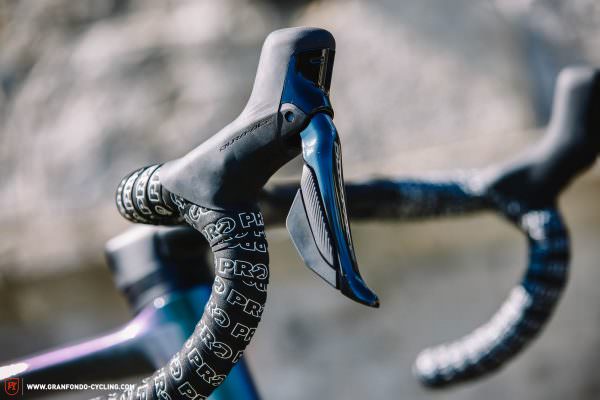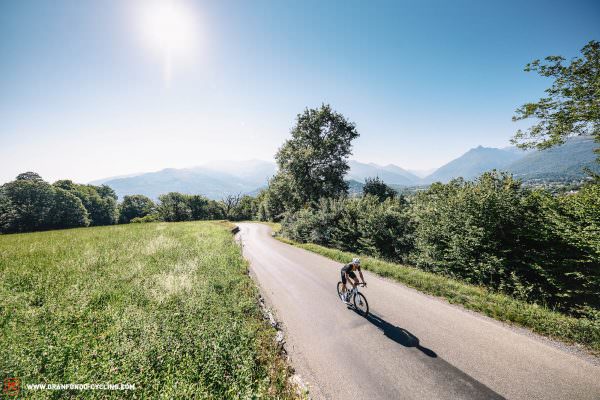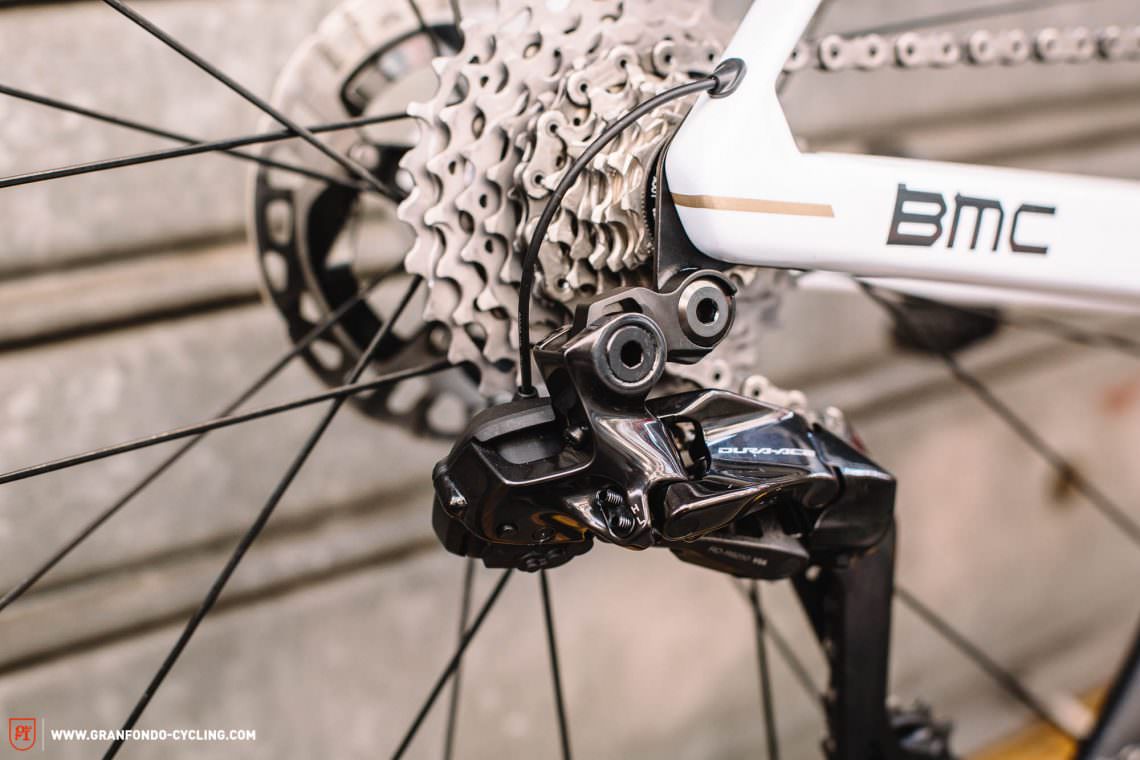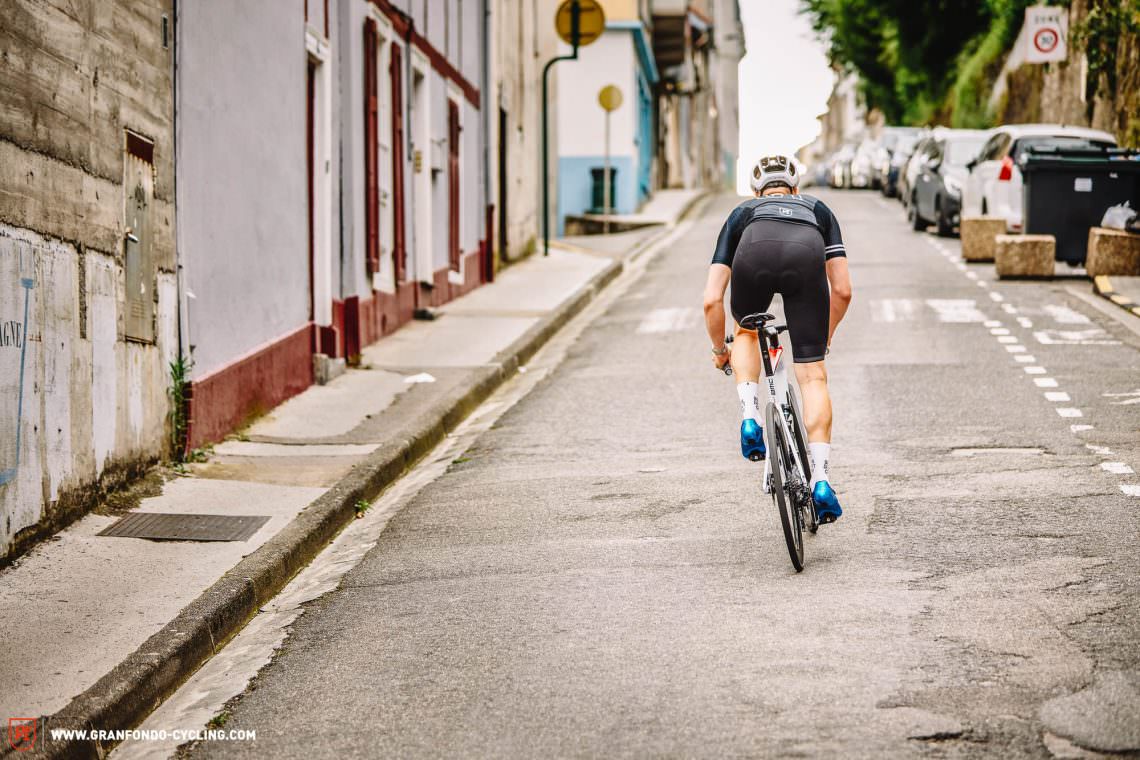With the Shimano DURA-ACE Di2 9200, the Japanese brand present the latest edition of their top end groupset, relying on a 12-speed drivetrain and wireless controls. In addition, they’re also introducing new brakes and wheels to the DURA-ACE range. Read on for all the details and our first ride review.

Shimano DURA-ACE has always been the Japanese component manufacturer’s top end groupset. For 2022, they’re introducing the latest edition of the flagship groupset, the DURA-ACE Di2 9200, aiming to catch up to their fiercest competitor, SRAM, with wireless controls and a twelfth sprocket on the cassette. At the same time, they promise to expand their lead in terms of shifting speed. Along with the drivetrain components, they’ve also got new brakes and wheels. We’ve gathered all the details for you here and already put some of the components to the test.
- Shimano DURA-ACE Di2 ST-R9270 DUAL CONTROL levers in detail
- Quick facts
- Shimano DURA-ACE Di2 ST-R9270 DUAL CONTROL levers – First ride review
- Our conclusion on the Shimano DURA-ACE Di2 ST-R9270
- Shimano DURA-ACE Di2 RD-R9250 rear derailleur in detail
- Quick facts
- Shimano DURA-ACE Di2 RD-R9250 rear derailleur – First ride review
- Our conclusion on the Shimano DURA-ACE Di2 RD-R9250
- Shimano DURA-ACE Di2 FD-R9250 front derailleur in detail
- Quick facts
- Shimano DURA-ACE Di2 FD-R9250 front derailleur – First ride review
- Our conclusion on the Shimano DURA-ACE Di2 RD-R9250
- Shimano DURA-ACE Di2 BR-R9270 brakes in detail
- Quick facts
- Shimano DURA-ACE Di2 BR-R9270 brake – First ride review
- Our conclusion on the Shimano DURA-ACE Di2 BR-R9270
- Shimano DURA-ACE FC-R9200 and FC-9200-P cranks
- Shimano DURA-ACE WH-R9270 wheels
- Our conclusion on the Shimano DURA-ACE Di2 9200

Shimano DURA-ACE Di2 ST-R9270 DUAL CONTROL levers in detail
As with any groupset, the controls are the rider’s only point of direct contact with the system. It’s no wonder that Shimano have placed so much emphasis on improving their ergonomics. The hoods have been angled further inwards and are higher, which creates more space under the handles. The shifter paddles on the ST-R9270 controls drop further down behind the brake lever and protrude slightly further outwards than on the previous model. All these changes should lead to better shifting and braking ergonomics. As before, the default function of the buttons on the STIs is to scroll through the interface of a Garmin, Wahoo or other device.

The most exciting, technical innovations can be found inside the Shimano DURA-ACE Di2 ST-R9270 DUAL CONTROL levers. The cable leading to the rear and front derailleur, as you’ll find on the predecessor, is no longer necessary and is replaced by Shimano’s proprietary wireless connection. The Shimano wireless IC (integrated circuit) is claimed to be four times as fast as the common Zigbee protocol while being 75% more energy efficient. It should also be less prone to interference. The controls are powered by one CR1632 coin battery in each unit, which is 4 mm smaller than those used by the SRAM eTap AXS groupset.



The rear and front derailleur still require a cable to connect them the battery, which gets inserted into the seat tube as before and gets charged via the rear derailleur. The wireless receiver for the controls is also located in the rear derailleur. To shift the front derailleur, the command goes from the rear derailleur, where it’s received, to the front derailleur via the battery. One battery charge should power the front and rear derailleur for around 1,000 km – of course, that depends largely on the topography and how often you shift. The shifting is claimed to be 58% faster at the rear and 45% faster at the front compared to the previous generation.

In addition to the Shimano DURA-ACE Di2 ST-R9270 DUAL CONTROL levers, the latest generation of the flagship Japanese groupset also caters to fans of rim brakes with the ST-R9250 model. With these, the shape remains the same as the previous model – only the colour has changed. The position of the brake levers can be adjusted by 14 mm, which should accommodate a large range of hand sizes.
Quick facts
- Wireless controls
- Coin batteries in the controls promise 1.5–2 years of service life
- Can still use cables as redundancy for maximum reliability
- Remote satellite shifters can be installed but the functions can’t be customised
- Quick shifting: 58% faster on the rear and 45% faster up front
- Proprietary Shimano wireless IC connectivity
- Weight: 350 g/pair



Shimano DURA-ACE Di2 ST-R9270 DUAL CONTROL levers – First ride review
The hoods of the Shimano DURA-ACE Di2 ST-R9270 have become significantly larger and, purely in terms of volume, are a lot more like those of the SRAM eTap AXS groupset than the previous model. That said, they’re very easy to hold onto and feel pleasantly soft and cushioned. The levers themselves are positioned slightly outwards and are easy to reach for both shifting and braking and can be easily adapted to your personal preferences by adjusting the reach and pressure point.



The individual shifter paddles for up- and downshifting are more clearly separated from each other on the new DURA-ACE and are therefore much easier to distinguished even on rough surfaces. As such, you’re a lot less likely to hit the wrong paddle. Due to the changed shape of the hoods, you can now comfortably fit three fingers behind the levers, which is very pleasant. The rubber covers of the hoods themselves are also impressive. On the ST-R9270 DUAL CONTROL units, they’re sturdy, don’t twist and retain their shape even after the brakes have been bled. It takes a long time to scroll through the pages of your on-board computer using the buttons integrated in the hoods.

Our conclusion on the Shimano DURA-ACE Di2 ST-R9270
The ergonomics of new Shimano DURA-ACE Di2 ST-R9270 DUAL CONTROL levers have been improved significantly compared to the previous model. They feel great and make a high-quality impression. Only a long term review will show whether the coin batteries last as long as promised.
Shimano DURA-ACE Di2 RD-R9250 rear derailleur in detail
On the latest generation of the Japanese brand’s top end groupset, the rear derailleur has become the heart of the system. The junction box, the Bluetooth and ANT+ receiver as well as the charging socket for the battery that powers the front and rear derailleur is located here. This means that the system’s most sensitive technology is housed in the most exposed component, which can be problematic, especially if you crash. However, if you want to convert to a 1x setup and remove the front derailleur, only the rear derailleur remains on the bike. As such, it’s the only logical place to put it. With all this additional hardware, the component now weighs 215 g, which is only 18 g more than the previous model. As the heart of the system, the rear derailleur not only acts as the receiver for its own shifting commands but also for those of the front derailleur, which must pass through a cable via the battery.

According to Shimano, the rear derailleur shifts 58% faster than before. A small part of this is due to the wireless communication between controls and the rear derailleur, which is faster than the wired connection of the previous version. However, it’s mostly due to improvements in the hardware. In other words, the component itself simply moves faster. In addition to the charging socket, the Shimano DURA-ACE Di2 RD-R9250 also has an LED display that provides information about the battery level, the connection between the controls and the rear derailleur and how to adjust the component. The look of the new DURA-ACE rear derailleur is unusual due to the long cage, which is the same for all cassettes and can now accommodate up to 34 teeth.



Quick facts
- Heart of the system: receiver for both the front and rear derailleur
- Three functions: charging the battery, Bluetooth and ANT+ connection, junction box
- Fastest shifting on the rear derailleur: 58% faster than its predecessor
- LED indicator for the battery, connection and adjustments
- Can accommodate a bigger cassette: max. 34 t
- The same cage for all cassettes
- Weight: 215 g

Shimano DURA-ACE Di2 RD-R9250 rear derailleur – First ride review
The new Shimano DURA-ACE Di2 RD-R9250 rear derailleur is said to be 58% faster at shifting gears. The complete process involves the communication time between the controls and the derailleur and the actual movement of the shifting mechanism. According to Shimano, the majority of the 58% is saved in the mechanical process. Indeed, the shifting is lightning-fast, not only in terms of the reaction of the rear derailleur but also the speed at which the chain jumps from one sprocket to the next. We can’t imagine it getting any better! And yet, whether a gear change takes just under 0.2 seconds, as with the old rear derailleur, or just under 0.1 seconds as it does now may not be all that important. However, the way the chain shifts is all the more exciting, moving from one gear to the next gear more smoothly and fluidly than with the predecessor. The loud snapping of the previous generation has become significantly softer.

The precision of the mechanism doesn’t suffer as a result either and there’s no rattling or rubbing to be heard! With this extremely fast and precise yet also somewhat smoother shifting, you quickly gain confidence in the rear derailleur and dare to shift in critical situations or under load, such as when you’re faced with an unexpected attack on a climb. The rear derailleur can easily deal with this and reliably shifts into the gear you want. The shifting logic can be largely adapted to your personal preferences using the associated Shimano app. It even allows you to adjust the shifting speed.


Our conclusion on the Shimano DURA-ACE Di2 RD-R9250
The new Shimano DURA-ACE Di2 RD-R9250 rear derailleur impressed us with extremely fast, precise and yet somewhat smoother shifting. We couldn’t have wished for more. The additional weight of the component compared to the previous model is acceptable considering the additional hardware hidden inside it. A long term review will have to show how long a battery charge lasts.
Shimano DURA-ACE Di2 FD-R9250 front derailleur in detail
The Shimano DURA-ACE Di2 FD-R9250 front derailleur features both optical and technical innovations. The first thing you’ll notice is how small the body of the mechanism has become. The frontal cross-section is a full 33% smaller, which is intended to reduce both the weight and the aerodynamic drag of the component. Another visual innovation is the high-quality black cage. In addition to the visual innovations, the majority of the changes can be found inside the derailleur. Unlike the rear derailleur, the FD-R9250 doesn’t communicate directly with the controls. Instead, it receives its commands via the rear derailleur. Since the signal must reach the front derailleur via the rear derailleur, the communication time is slightly longer than with the previous model where it was sent directly to the component via a cable.

Despite the longer traveling time of the shifting signal, the total shifting process is 45% quicker. That shows that the second big innovation in the FD-R9250 front derailleur is in the hardware itself. The linkage that connects the cage to the body of the derailleur and the internal servomotor has been rearranged. This enables the motor to push the cage inwards or outwards more quickly. The arrangement of the mechanism and the size of the cage allow for large chainrings between 50 t and 55 t. That should be enough range for most scenarios and, in combination with the 11 t sprocket of the cassette, is on the same level as the 50 t chainring of the SRAM eTap AXS groupset with a 10 t sprocket.
Quick facts
- Fastest shifting on the front derailleur 45% faster than before
- Receives its shifting signal via the rear derailleur
- 33% smaller frontal cross-section
- Accommodates large chainrings from 50–55 t
- Weight: 96 g

Shimano DURA-ACE Di2 FD-R9250 front derailleur – First ride review
From a performance perspective, the front derailleur of the Japanese brand’s flagship groupset was superior to its competitors from SRAM and Campagnolo even before the update. The latest generation FD-R9250e extends this lead even further. It shifts quickly and accurately in all circumstances, without fail. Expressed as a percentage, the increased shifting speed of the new model might be slightly less than the rear derailleur, but it is still noticeably quicker than before.



The chain doesn’t hesitate for a second before jumping up or down the chainring. On the contrary, it shifts to the smaller or bigger gear almost instantly. Regardless of whether you want to shift back into a higher gear as you crest a hill or shift down on a steep climb while cranking the pedals. The derailleur won’t let you down. Due to the black cage and the compact size, the component also blends very inconspicuously with the bike.

Our conclusion on the Shimano DURA-ACE Di2 RD-R9250
The Shimano DURA-ACE Di2 FD-R9250 front derailleur impressed us with very fast and precise shifting in every situation. Thanks to this and its compact yet high-quality design, it underlines and consolidates Shimano’s claim to have the best groupset on the market.
Shimano DURA-ACE Di2 BR-R9270 brakes in detail
The Japanese brand have made many adjustments to improve the performance of the Shimano DURA-ACE BR-R9270 brakes. First of all, they now feature so-called SERVO-WAVE technology. Put simply, this acts like a booster. Combined with a 13% larger lever throw, this pushes more hydraulic fluid through the brake line and allows Shimano to move the brake pads 10% further from the rotor. In addition, the new RT-MT900 rotor is said to deform 66% less when exposed to heat compared to the predecessor. Put together, this should result in the brake pads dragging less on the rotors.


The brake calliper is new too, which is now made from one piece, reducing the weight by 17 g compared to the previous model, coming in at just 233 g per pair. In addition, the monoblock design is said to offer increased stiffness and could be one of the factors leading to their increased stopping power. The brake pads themselves feature a new compound, which is a second possible factor leading to improved braking power. Fortunately, the pads have the same shape as the previous model and you can use them to upgrade your existing DURA-ACE brakes. Lastly, the bleeding process has been improved and the screws for the bleed port and vent valve are no longer in the same place, which makes the process much easier. What’s more, the brake calliper can remain on the frame while bleeding. The RT-MT900 rotors are reminiscent of the Shimano XTR rotors from the mountain bike sector, which some might find a bit unrefined looking for a road bike.



Quick facts
- 10% more space between rotor and pads for less rubbing
- 13% larger lever throw compared to the predecessor
- 66% less thermal deformation of the RT-MT900 rotor
- Improved bleeding process
- Brake pads made of a new compound while retaining the old shape
- Monoblock brake calliper for improved stiffness and less weight
- Weight: 233 g (per pair)
Shimano DURA-ACE Di2 BR-R9270 brake – First ride review
The modulation of the brakes isn’t immediately intuitive, as the action of the brake levers feels very light. As a result, the linear modulation feels progressive. We recommend taking some time to get used to this braking behaviour and carefully modulate how much you pull on the brake levers. On the other hand, this system allows you to apply a lot of braking force with a single finger. Even after long descents with a lot of braking, you’ll only need to pull the front brake with one finger to come to a halt.



The additional clearance between the rotors and pads in combination with the reduced thermal deformation of the rotors pays off. After long descents with the BR-R9270 and a rider weight of 85 kg, the brakes never dragged, even when we made the frame flex by standing up to pedal and leaning the bike from side to side immediately afterwards. Unfortunately, we can’t say anything about the braking in wet conditions, as we enjoyed a beautiful, sunny day on our test ride up to Luz Ardiden and back down into the valley. The only thing we can say for sure is that you’ll have to be even more careful on the brake levers in the wet. But that goes without saying.

Our conclusion on the Shimano DURA-ACE Di2 BR-R9270
The Shimano DURA-ACE BR-R9270 brakes feature many innovations that make sense on paper and also delivered in the real world. The massively improved braking power will allow experienced riders to set new personal bests on the descents. That said, the rather unintuitive modulation can be a bit annoying. Mechanics and do-it-yourselfers will be happy about the easier bleeding process.
Shimano DURA-ACE FC-R9200 and FC-9200-P cranks
Other key components of the new DURA-ACE Di2 9200 groupset include the cranks. You can choose between the DURA-ACE FC-R9200 crankset, which comes without a power meter, and its big sister, the FC-R9200-P, which features a dual-sided power meter. Both versions feature HOLLOWTECH II technology, made from two parts and then glued together. They are still made entirely of metal and Shimano show their expertise in the processing of this material. They look beautiful and make a very high-quality impression with their glossy finish.


According to Shimano, the cranks featuring HOLLOWTECH II technology should offer an optimal balance of stiffness, weight and pedalling performance. The differences are said to be noticeable, offering improved power transfer and more precise shifting of the of the front derailleur. We can confirm both from our first test ride. New to the range is a 54/40 t crankset, which is said to offer improved drivetrain efficiency. The proven 52/36 t and 50/34 t cranksets are also available. Regarding the length of the crank arms, you have a choice of seven options ranging from 160 mm to 177.5 mm. The Q-factor of the Shimano FC-R9200 and FC-R9200-P cranks is 148 mm.



Shimano DURA-ACE WH-R9270 wheels
As before, Shimano rounds off the DURA-ACE range with a set of complete wheels, allowing you to choose between three rim depths, all of which are made of carbon. For tubular tires, all variants are available as disc and rim brake models. The tubeless-ready versions are disc brake specific only. Regarding the profile depths, you can choose between 36 mm for use on mountain passes, 50 mm for all-round use and 60 mm for flat stages or finish-line sprints. All tubeless-ready versions have an inner width of 21 mm and the tubular versions have an outer width of 28 mm. Note that all the new DURA-ACE wheels are exclusively compatible with the new Shimano 12-speed cassettes.

Our conclusion on the Shimano DURA-ACE Di2 9200
With the new Shimano DURA-ACE Di2 9200 groupset, Shimano are extending their lead in shifting performance over SRAM and Campagnolo and are now on par with their US and Italian competitors when it comes to braking power. The Japanese brand have made sensible improvements to almost every component in their flagship range, delivering a convincing performance across the board in our first ride review. We’re curious to find out what a long term test will reveal.
For more information about the Shimano DURA-ACE Di2 9200 groupset, visit shimano.com.
Did you enjoy this article? If so, we would be stoked if you decide to support us with a monthly contribution. By becoming a supporter of GRAN FONDO, you will help secure a sustainable future for high-quality cycling journalism. Click here to learn more.
Words: Tobias Hörsch & Benjamin Topf Photos: Benjamin Topf, Irmo Keizer/Andreas Dobslaff (Shimano)























































